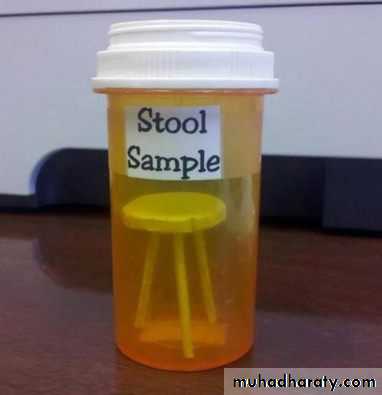Lab 1
Specimen Collection and ProcessingStool Examination for Ova and Parasite
• The most common procedure contain two general components :Macroscope.
Microscope.
Collection
TransportFixatives
2
Collection
The typical stool collection protocol consists of three specimensOne specimen collected every other day or a total of three collected in 10 days
Because parasites are often shed ( enter and subsequently passed in the stool ) intermittently they may not appear in the stool specimen , therefore , multiple specimens are recommended for adequate detection.
3
• Stool specimen should be :-
• Collected in clean , water tight container with a tight fitting lid.
• The amount of stool required is 2-5 gm.
• Urine should not be allowed to contaminate the stool .
4
• The specimen container should be labeled with :-
Patient’s nameIdentification number.
Physician’s name.
Date and time of sample collection.
Other information such as suspected diagnosis.
5
6
Composition of Stool
¾ Water, ¼ SolidUndigested and Unabsorbed food
Intestinal secretions, Mucous
Bile pigment and Salts
Bacteria and Inorganic material
Epithelial cells, Leukocytes
7
Transportation
The specimen should be placed into a zip lock plastic for transport to the laboratory.
When handling all specimens , gloves and a protective coat should be worn at all times.
Another important consideration in testing fecal specimen is the time frame from collection to receipt and examination in the lab.
8
Trophozoite stage is sensitive to environmental changes and on release from the body disintegrates rapidly.
Other parasite stages (cyst, helminthes eggs , larvae) are not as sensitive and can survive for longer periods outside the host.
9
Liquid stool contain Trophozoite within 30 minutes.
Semi form stool contain both cyst andTrophozoite within one hour.
Formed stool not likely to contain Trophozoites within 24 hours.
If delayed store in a refrigerator (4 Cº).
10
Fixatives for preservation
Fixatives are substances that preserve the morphology of the protozoa and prevent further development of certain helminthes eggs and larvae.The ratio of fixative to stool is important ( 3 part fixation to one part stool )
The specimen should mixed well with the preservative to achieve thorough fixation.
The specimen must be fixed in the preservative for at least 30 minutes before processing begins.
11
Types of preservatives
• 10% formalin• Sodium acetate formalin (SAF)
• Polyvinyl alcohol (PVA)
• Modified PVA
12
Formalin
Formalin : 5%, 10%Formalin may be used routinely for direct examination and concentration process but not for permanent smears.
13
Advantages
• easy to prepare.• It preserves specimen up to several years.
• It had a long shelf live
Disadvantages
• Trophozoite cannot be recovered.
• Morphological details of cyst and egg may fade with time.
• It does not preserve parasite morphology adequately for permanent smears.
14
Polyvinyl alcohol (PVA)
It is composed of a plastic powder that act as an adhesive for the stool specimen .PVA is most often combined with schaudim solution
Advantages
It can be used for preparation of permanent stained smear.
Disadvantages
Schaudim solution contains mercuric chloride that lead to potential health problem.
15
Processing
Once a stool sample had been received in the laboratory, the analytic phase of laboratory begins.Macroscopic examination:
• The color :- normal color of stool is brown.
• The consistency indicate the type of parasites.
• Gross abnormalities (the stool should be fresh unpreserved )Pinworm pus, proglottids , bleeding
16
17
Microscopic examination (3 procedures)
• Direct wet preparation• Concentrated technique.
• Permanent stained smear.
18
Direct wet preparation
Direct saline wet preparation• Drop of 0.85% saline on glass slide .
• Unfixed stool on glass mixed with wooden stick.
• The mixture covered with cover slip.
• Low power (10x, 20x, 40x).
19
20
Direct Iodine wet preparation
• Drop of 0.85% saline on glass slide .• Unfixed stool on glass mixed with wooden stick.
• A drop of iodine placed on the preparation.
• The mixture covered with cover-slip.
• Low power (10x, 20x, 40x).
21
22
Concentration method
Detect small number of parasitesAggregate parasites present into a small volume of sample and to remove as much debris as parasite.
Performed on both fresh and preserved stool.
There are two types:-
• Sedimentation.
• Flotation
23
Permanent stain
The final procedureDefined as a microscopic slide that contain a fixed sample that has been allowed to dry and subsequently stained
Used to confirm the presence of protozoa cysts and trophozoite.
Observe detailed features of protozoa by staining intracellular organelles.
24
• The two common stains :-
Trichrome:- the most widely used permanent stain.Iron haematoxylin.
25
26
Other Intestinal Specimens
• Duodenal material (Giardia intestinalis trophozoite)• Sigmoidoscopy material (Entemobia histolytica )
• Cellophane tape preparation(Enterobius vermicularis & Taenia spp.)
27
Other Specimens
• Blood: Leshmania donovani and Trypanosome spp. Plasmodium spp.
Two types of smears (thick and thin)
Two permanent stains :- Wright stain and Giemsa stain(the preferred stain because it allow for the detection of parasite details).
28
• CSF fluid (Acanthamoba and Trypanosome spp.)
• Tissue and biopsy specimen for intracellular organism such as Leshmania spp. and Toxoplasma gondii.
• Sputum (Strongyloid stercolaris)
• Urine and genital secretion (Schistosoma hematobium and Trichomonas vaginalis)
• Culture methods
29
Xenodiagnoses
Is a diagnostic method used to document the presence of infectious disease microorganism or pathogen by exposing the infected tissue to a vector and then examine the vector for the presence of microorganism or pathogen it may have ingested.30
31







